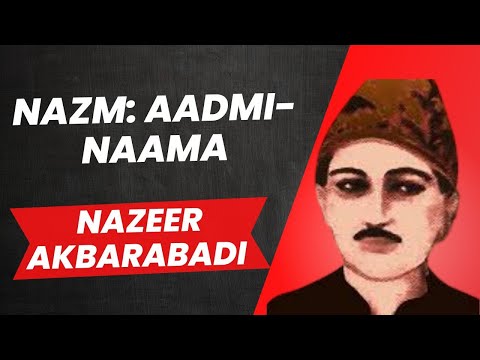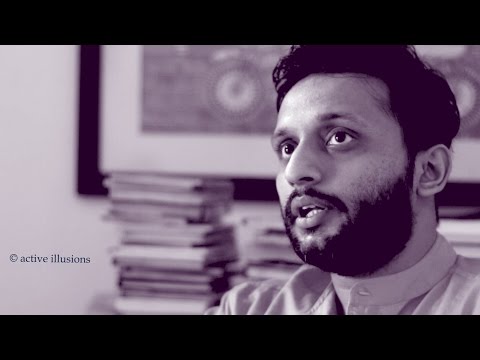May 17, 2011
17th May
#shairoftheday
Nazeer Akbarabadi (real name “Wali Muhammad”) was an Indian poet of 18th century who wrote Urdu ghazals and nazms under nom de plume “Nazeer”. His father was Muhammad Farooq and his mother was the daughter of Nawab Sultan Khan who was the governor of Agra Fort. Agra, the Indian city, was known as Akbarabad after Mughal emperor Akbar at that time.
Nazeer’s date of birth is not certain but most of his biographers believe that he was born in Delhi (then called “Dihli”) in 1735 AD. The period of his birth coincided with the decline of the Mughal empire in India.
In 1739 Nazeer was still a child when Nadir Shah attacked Delhi and Muhammad Shah Rangeela was arrested. He was later released but countless people were mercilessly killed in Delhi. The horrors of this plunder were still fresh in the minds of people when 18 years later, in 1757 AD, Ahmad Shah Abdali attacked Delhi. People left Delhi for safer cities. Nazeer along with his mother and grandmother also abandoned Delhi and migrated to Akbarabad. At this time Nazeer was 22 years old.
It is said that Nazeer’s poetic treasure consisted of about 200,000 verses but unfortunately a bigger portion of it is destroyed and only 6000 verses are available in printed form. No other Urdu poet used as many words as Nazeer did. Nazeer’s poetry conveyed the plight of the common people in their own everyday language and was very popular among the masses. It was due to this lack of the “elite” element perhaps that Nazir’s genius was not recognized until much later.
But in spite of this neglect, some of his poetic treasure is still available and some of his poems, such as Banjara Nama (chronicle of a nomad/gypsy), Kaljug nahin karjug hai yeh, Aadmi Naama (chronicle of man), etc., became immortal. Such poems find their place in school text books and discerning fans of Urdu poetry will not fail to recognize the greatness of Nazeer’s verse.
His poetic treasure has some immortal poems like “Banjara Nama”, “Kaljug nahin karjug hai yeh”, “Aadmi Naama” (Chronicle of man) etc. These poems are also in school text books and anticipating fans of Urdu poetry will not fail to recognize the glory of Nazeer’s verse. He was purely a people’s poet and his nazams reflects various aspects of daily life of his era. He wrote on all types of religious and social events with all minor details in which common people can be seen laughing, singing, teasing and playing. He wrote nazams on various social festivals like “Diwali, Holi, Eid, Shab-e-baraat” and about animals, birds, seasons and even on inanimate objects like “paisa, rupaiaa, rotiyaan, aata-daal (flour and lentils), pankha (fan), and kakrhi (a kind of cucumber)”.
He also wrote nazams about different aspects of human life like “muflisi” (Poverty) and “kohrinamah” (Chronicle of leper). Nazeer Akbarabadi died in 1830 AD at the age of 98.
From Wikipedia
Banjaranama
gar tuu hai lakhi Banjara aur khep bhi teri bhaari hai,
ai ghaafil tujhse bhi chadhta ek aur bada vyapari hai,
kya shakar,misri,kand gari, kya sambhar meetha khari hai
kya dakh munaqqa sonth ,mirch, kya kesar laag supari hai
sab thaath pada rah jayega , jab laad chalega banjara
sab thaath pada rah jayega / jab laad chalega banjara
Mohd. Zeeshan Ayub : Banjaranama : Nazir Akbarabadi : Urdu Studio with Manish Gupta Aadmi nama
Duniya mien badshah hai so hai woh bhi aadmi
aur muflis o gada hai so hai woh bhi aadmi
zar dar be nawa hai so hai woh bhi aadmi
ne’amat jo kha raha hai so hai woh bhi aadmi
tukde jo mangta hai so hai woh bhi aadmi
abdaal o qutb o ghaus o wali aadmi hui
munkar bhi aadmi hue aur kufr se bhare
kya kya karishme kashf o karamat ke kiye
had ta ke apne zor o riyazat ke zor pe
khaliq se ja mila hai so hai woh bhi aadmi
fir’aun ne kiya tha jo daawa khudai ka
shaddad bhi bahisht bana kar hua khuda
namrud bhi khuda hi kahaata tha bar mala
yeh baat hai samajhne ki aage kahoon main kya
yan tak jo ho chuka hai so hai woh bhi aadmi
yan aadmi hi naar hai aur aadmi hi noor
yan aadmi hi paas hai aur aadmi hi door
kul aadmi ka husn o qaba mien hai yaan zahoor
shaitaan bhi aadmi hai jo karta hai makr o zor
aur haadi, rehnuma hai so hai woh bhi aadmi
masjid bhi aadmi ne banai hai yan miyan
bante hain aadmi hi imaam aur khutba khwan
padhte hain aadmi hi namaaz aur quran yan
aur aadmi hi un ki churaate hain jootiyan
unko jo tadhta hai so hai woh bhi aadmi
yan aadmi pe jaan ko ware hai aadmi
aur aadmi hi tegh se maare hai aadmi
pagrhi bhi aadmi ki utaare hai aadmi
chilla ke aadmi ko pukare hai aadmi
aur sun ke daudhta hai so hai woh bhi aadmi!
Holi
Jab khele holi Nandlalan, hans hans nandgaon basyan main ll Nar naari ko anand hoye khushwaqti chhori chayan main
जब खेली होली नंद ललन हँस हँस नंदगाँव बसैयन में।
नर नारी को आनन्द हुए ख़ुशवक्ती छोरी छैयन में।।
कुछ भीड़ हुई उन गलियों में कुछ लोग ठठ्ठ अटैयन में ।
खुशहाली झमकी चार तरफ कुछ घर-घर कुछ चौप्ययन में।।
डफ बाजे, राग और रंग हुए, होली खेलन की झमकन में।
गुलशोर गुलाल और रंग पड़े हुई धूम कदम की छैयन में।

